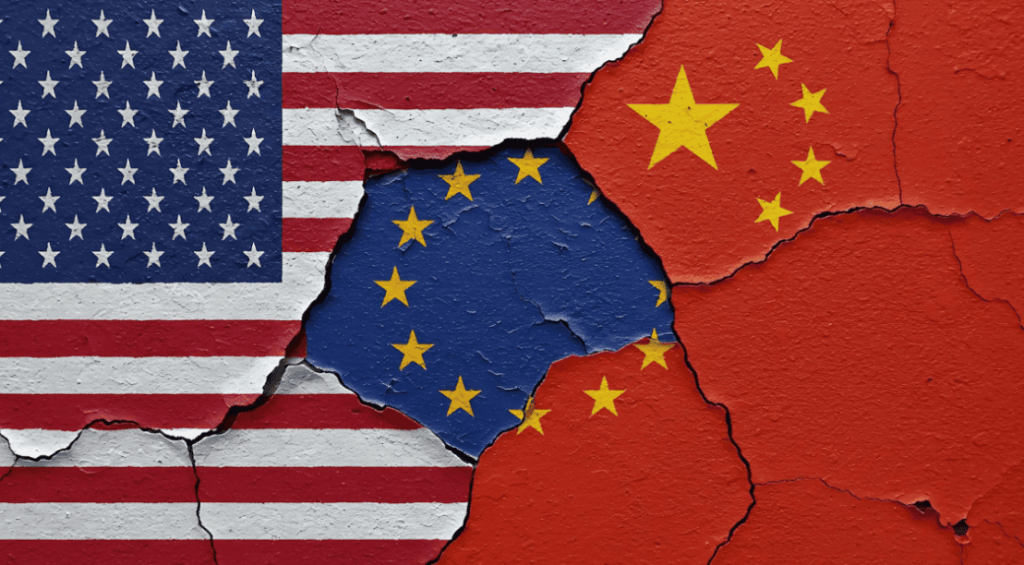Geopolitical issues are flooding current political and economic debate, but evidence is limited on their interplay with structural policies. Combining information on geopolitical risks and the EU cohesion policy, this column evaluates the costs of geopolitical tensions in terms of reduced effectiveness of structural funds. The results indicate that the impact of the cohesion policy is reduced once considering geopolitical risks originating from the US and China, with asymmetries across European countries. Evidence claims for the coordination between structural and other EU-wide policies in Europe.
The last decade has been characterized by an increase in global political tensions that have amplified economic uncertainty worldwide (Campos et al. 2023). A series of shocks has produced a fragmented geo-economic environment (Aiyar et al. 2023) in which policymakers and economic actors currently operate and take decisions. In mid-October 2023, when a new Hamas–Israel conflict started, the index from Caldara and Iacoviello (2022) measuring global geopolitical risk (GPR), which provides a summary measure of global issues due to wars, terrorism, and other tensions, was about three times higher than at the beginning of that month.
By feeding economic uncertainty, geopolitical tensions can have complex negative implications for consumption, investment, and saving decisions, and, in turn, for the effectiveness of structural policies (Orszag et al. 2022, Coibion et al. 2025). Although there has been rapid growth in research on the economic implications of geopolitical changes (Baldwin and Freeman 2022, Bosone et al. 2024), less is known about the relationships between structural policies and geopolitical risk. The EU cohesion policy is a key structural policy aimed at reducing regional disparities and promoting growth in the Union (Di Caro and Fratesi 2022, Canova and Pappa 2025). In the financial framework 2021-2027, the policy accounts for about one-third of the total EU budget. In June 1988, when the cohesion policy became a core policy of the European integration process, the global GPR index (30-day average) was about 83; in February 2022, when the Russia-Ukraine war started, the index doubled to reach a value of 168, one of the highest values over the past four decades. Policy evaluations conducted without considering GPR are thus less informative today.
In recent work (Arbolino et al. 2025), we construct a country-specific measure of exposure to geopolitical issues based on a trade-adjusted version of the news-based GPR index (Caldara and Iacoviello 2022). Specifically, we measure the trade exposure of EU countries to GPR originating from the US and China – the two main foreign trade partners of the EU and the global players that likely drive most recent and future global risks. We combine information from the GPR index with novel data on the sector-specific breakdown of the cohesion policy covering the years 2007-2020. Over this period, more than €325 billion was allocated to supporting the industrial sector in the EU (about 21.5% of total cohesion funds). We apply a panel time series heterogeneous coefficient model in order to evaluate the uneven impact of GPR on the effectiveness of cohesion funds allocated to the manufacturing sector across Europe.
The impact of GPR on the effectiveness of cohesion funds is calculated by comparing the results with and without the inclusion of the variables describing geopolitical risks. In Figure 1, we report the estimated average impact of the EU cohesion policy funds on the manufacturing gross value added (GVA) in three different scenarios: (1) without the inclusion of information on GPR (GPR_free); (2) with the inclusion of GPR originating from the US (GPR_US); and (3) with the inclusion of GPR originating from China (GPR_CHN).
Figure 1 How GPR can reduce the effectiveness of cohesion policy


Note: The graph reports the estimated impact of the cohesion funds (in the industrial sector) on manufacturing GVA, as obtained from: model with no GPR (GPR_free bar); model including GPR from the US (GPR_US bar); model including GPR from China (GPR_CHN bar). For more details, see Arbolino et al. (2025).
Our results indicate that the effectiveness of the EU funds is reduced on average by about 13% when geopolitical risks from the US are included in the analysis, ceteris paribus. This finding supports the view that tensions coming from the US contribute to rising global economic uncertainty on both the supply and demand side, with possible negative implications for investment decisions and the effectiveness of public policies. The reduction in the impact of the cohesion policy is particularly relevant when we disaggregate the trade-adjusted GPR index of the US by considering the export channel only, confirming the pivotal role of the US as a destination market for EU manufactured goods (Bottazzi et al. 2025).
We find that the impact of cohesion funds in the industrial sector is reduced even more (by about 30% on average) when considering GPR originating from China. One possible reason for the greater higher cohesion policy costs resulting from GPR from China compared to the US could be the concentration of the impact of Chinese geopolitical tensions in the European countries that receive large amounts of cohesion funds, such as Central and Eastern countries, which have been progressively integrated with China. As expected, and given China’s pivotal role as an input provider for Europe, the diminishing impact of the cohesion policy is more marked when we disaggregate the trade-adjusted GPR index for China by considering the import channel only.
Cross-country heterogeneity
One can expect that the consequences of geopolitical risks for structural policies are asymmetric across countries, given the presence, among other factors, of heterogeneous trade linkages between European nations and the countries of origin of geopolitical tensions (Attinasi and Mancini 2025). To dig deeper, the model that we apply allows for the calculation of the country-specific impact of GPR on the effectiveness of cohesion funds. This approach is useful to disentangle the presence of country heterogeneity when calculating the costs associated with GPR originating from the US and China.
In Figure 2, we show the estimated reduction in the expected impact of the cohesion funds on the manufacturing sector with respect to baseline estimates (without the inclusion of GPR) from a 10% increase in GPR. We compare the results including GPR from the US (panel a) and including GPR from China (panel b).
Figure 2 Asymmetric costs of GPR on cohesion policy impact in selected EU countries


Note: The figure reports the estimated reduction in the impact of the cohesion funds on the manufacturing GVA, with respect to baseline estimates (without the inclusion of GPR) as obtained from model including GPR from the US (GPR from China). Results refer to years 2007-20 and are shown for some selected EU countries for which we obtain significant individual coefficients in all the model specifications. Country label: AUT (Austria); BEL (Belgium); CZE (the Czech Republic); GER (Germany); HUN (Hungary); ITA (Italy); POL (Poland); SLO (Slovenia). For more details, see Arbolino et al. (2025).
The major adverse impacts of GPR from the US on the effectiveness cohesion funds (Figure 2a) are registered in Italy, Belgium, and Slovenia. Negative consequences are also observed in the Czech Republic, Hungary, and, to a lesser extent, in Germany. The uneven distribution of the costs of GPR in terms of reduced cohesion policy effectiveness can derive from a combination of different factors: trade linkages with the country of origin of GPR, the amount of cohesion funds received, and firm dimensions in the manufacturing sector. In the case of Italy, for instance, the result can be explained by the facts that (i) Italian manufacturing is highly connected with the US, (ii) Italy receives a large share of cohesion policy funds compared to other old member states, and (iii) Italy’s manufacturing sector is characterised by small and medium-sized enterprises to a greater degree than countries such as Germany.
The picture changes when looking at the consequences of GPR from China (Figure 2b). In this case, the major adverse consequences in terms of reduced effectiveness of the cohesion funds are estimated to occur mostly in the new member states such as the Czech Republic, Hungary, and Poland, as well as in Germany. These findings support evidence on the relevant role of Chinese economic and political decisions for Central and Eastern European countries (Gopinath et al. 2025). The reduction in the effectiveness of the cohesion policy in the industrial sector in Germany points to the high level of exposure of Germany to shocks originating from China. Indeed, German manufacturing largely imports machinery, transport, and other processing equipment directly from China or indirectly through Central and Eastern European countries (Balteanu et al. 2024).
Key policy messages
In a world of daily geopolitical tensions, evaluations of the effectiveness of structural policies must consider the influence of geopolitical issues in order to be useful for policymaking. This is particularly true in Europe, where most countries are key actors on the geo-economic map and geopolitical threats exist close to its borders (Pisani-Ferry et al. 2023). Although further research is needed to unveil the complex interactions between geopolitical tensions and structural policies, including how structural policies can boost resilience to geopolitical shocks, our evidence highlights how considering the geopolitical dimension can provide insights into the effectiveness of the EU cohesion policy, one of the historical core EU-wide policy instruments.
Our analysis, which is subject to some caveats, provides evidence on the necessity of adopting a coordinated and flexible approach across different European policies (trade policy, industrial policy, cohesion policy, etc.) to obtain effective growth and development returns from structural policies in the midst of global uncertainty.
Source : VOXeu



































































